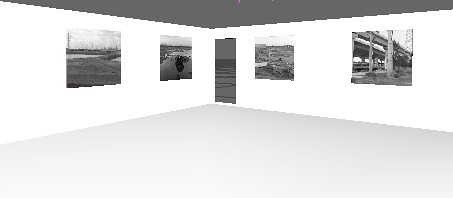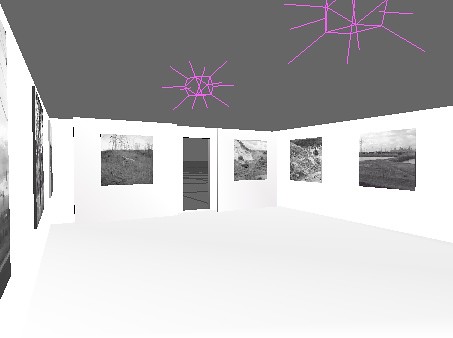art Archives
August 19, 2006
August 27, 2006
North Carlton's Lanes

Returned to the lanes in the North Carlton area recently, a gold mine of material, texture shapes and forms.
Met a chap who was adamant that the problem with image size and CCD's was the software not the the acutal CCD's themselves. He claimed it was possible to make a program convert a square to anything you wanted, ergo, square pixels become round. I think he didn't understand how CCD's work.
August 30, 2006
September 4, 2006
New Set
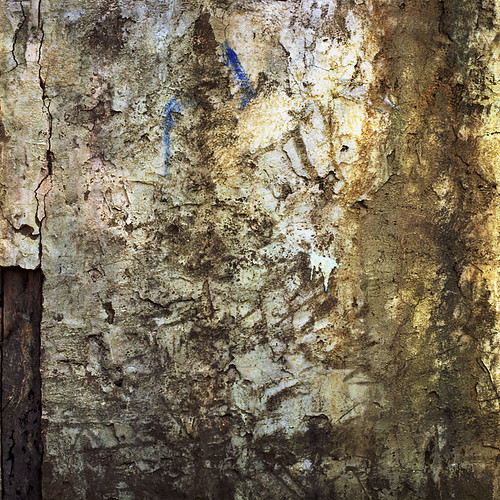
A new set, from the Hasselblad, and North Carlton's lanes.
September 7, 2006
More Roids...
I've not a lot to say at the moment, here's another Polaroid image from the roid rage project
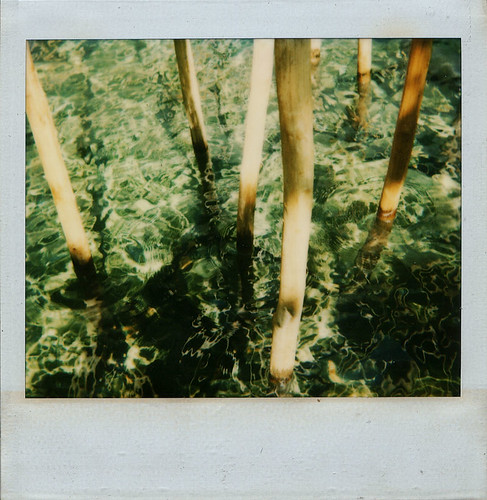
More Roids...
I've not a lot to say at the moment, here's another Polaroid image from the roid rage project

September 8, 2006
Musical Ponderings?
"All art constantly aspires towards the condition of music".
Walter Pater
This quote has long fascinated me, don't get me wrong though, I am no musician by any stretch of the imagination, one day I'll learn a musical instrument I guess? But it, the quote, often makes me wonder about my own photography and music, not to mention photography generally.
Everyone can 'listen' to a song, but how many really 'hear' it. Many people can play musical instruments, sing, but how many can write a song, a good one I mean. One that captures people's imaginations, the public consciousness, sticks in history as a memorable moment time or place?
The same applies I feel to photography, even more so now that digital has become so pervasive.
What makes a song or piece of music special?
What makes a photograph special then? How does one create an image that resonates at as many levels as possible, is there even a formula? Does it all matter in the end? Is there a connection between the two music and photography?
Does this image make any sound/s?
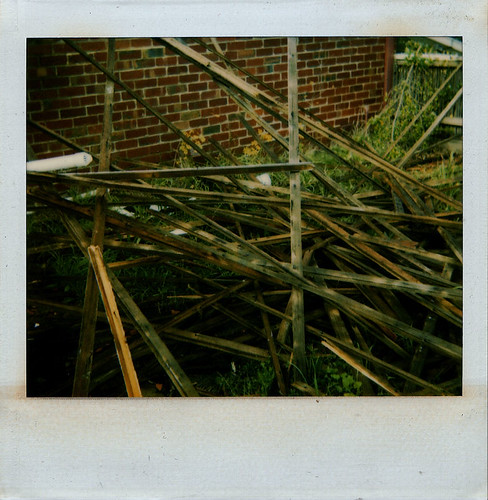
Musical Ponderings?
"All art constantly aspires towards the condition of music".
Walter Pater
This quote has long fascinated me, don't get me wrong though, I am no musician by any stretch of the imagination, one day I'll learn a musical instrument I guess? But it, the quote, often makes me wonder about my own photography and music, not to mention photography generally.
Everyone can 'listen' to a song, but how many really 'hear' it. Many people can play musical instruments, sing, but how many can write a song, a good one I mean. One that captures people's imaginations, the public consciousness, sticks in history as a memorable moment time or place?
The same applies I feel to photography, even more so now that digital has become so pervasive.
What makes a song or piece of music special?
What makes a photograph special then? How does one create an image that resonates at as many levels as possible, is there even a formula? Does it all matter in the end? Is there a connection between the two music and photography?
Does this image make any sound/s?

September 12, 2006
Desert Polaroid
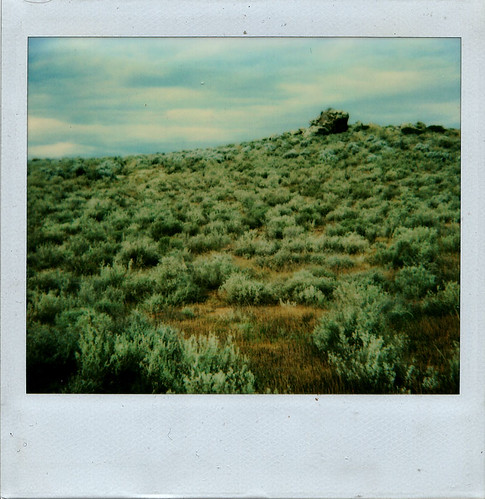
More from the roid rage project.
Desert Polaroid

More from the roid rage project.
September 16, 2006
I Dare You!
Recently was asked to shoot a commercial job for a friend for the poster he is designing for the BDYFF [Blue Dandenongs Film Youth Film Festival]. It was fun and lightning paced.
This is a rarity for me, as my output is generally more contemplative and ambiguous.

The above shot, one of my favourites, worked out perfectly, a little puff of breeze blew the stuntman's cape just the right amount to make the composition perfect.
Knowing Trav, the finished poster and al round advertising for the Film Festival will no doubt be funny interesting and engaging.
I learnt a little about working in these situations and may even take on more work in the future with this kind of stuff. One of the distinct advantages to digital no doubt.
I Dare You!
Recently was asked to shoot a commercial job for a friend for the poster he is designing for the BDYFF [Blue Dandenongs Film Youth Film Festival]. It was fun and lightning paced.
This is a rarity for me, as my output is generally more contemplative and ambiguous.

The above shot, one of my favourites, worked out perfectly, a little puff of breeze blew the stuntman's cape just the right amount to make the composition perfect.
Knowing Trav, the finished poster and al round advertising for the Film Festival will no doubt be funny interesting and engaging.
I learnt a little about working in these situations and may even take on more work in the future with this kind of stuff. One of the distinct advantages to digital no doubt.
September 25, 2006
This Is Not A Pipe
Looking over my left shoulder as I sit in my study at home, this is the image I see…

I remember when I was at Uni, one of my peers claimed he could never make an image unless in a foreign or exotic place, bah humbug I say. I can't walk 10 metres some days without being bowled over by the visual cacophony that is around me. This image proves my point.
I hope.
This Is Not A Pipe
Looking over my left shoulder as I sit in my study at home, this is the image I see…

I remember when I was at Uni, one of my peers claimed he could never make an image unless in a foreign or exotic place, bah humbug I say. I can't walk 10 metres some days without being bowled over by the visual cacophony that is around me. This image proves my point.
I hope.
September 30, 2006
Hooray
Peter Marshall over on about.com, had this to say about Robert Adams, one of my heroes and recent award winner, of the prestigious, Deutsche Börse Photography Prize
Adams pictures in some ways buck recent trends both in art and photography. They are relatively small and finely made prints, and in black and white. Shot of course on film. Of the four sets of work, his was the most traditionally photographic, and the kind of work that any new photographer would find most difficult to get accepted by the galleries today, neither commercial nor fashionable. It's good to see it recognised.
Now how to use this to get my solo show exhibited, in 2007?
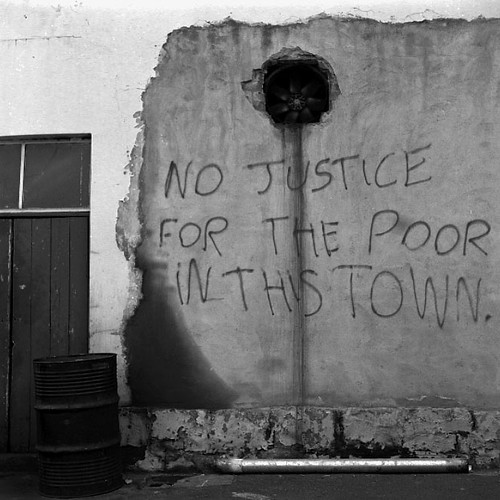
The article also introduced me to this body of work, taken over a time frame of 5 years by Alec Soth. An eclectic and interesting series of images, with heavy religious undertones, a subtle reference to sleeping and some connections to some of the areas in and around the Mississippi river.
Hooray
Peter Marshall over on about.com, had this to say about Robert Adams, one of my heroes and recent award winner, of the prestigious, Deutsche Börse Photography Prize
Adams pictures in some ways buck recent trends both in art and photography. They are relatively small and finely made prints, and in black and white. Shot of course on film. Of the four sets of work, his was the most traditionally photographic, and the kind of work that any new photographer would find most difficult to get accepted by the galleries today, neither commercial nor fashionable. It's good to see it recognised.
Now how to use this to get my solo show exhibited, in 2007?

The article also introduced me to this body of work, taken over a time frame of 5 years by Alec Soth. An eclectic and interesting series of images, with heavy religious undertones, a subtle reference to sleeping and some connections to some of the areas in and around the Mississippi river.
October 2, 2006
Self referential...
...how POMO!
I just realised today that, a while back I grumbled about the physical size of contemporary photographic art, in Melbourne in particular.
And 2 days ago, I was pleased to announce an award given to a photographer who's work I admire whose most recent body of work, is in fact small and finely printed.
*Cue spooky Twilight Zone type music*
Self referential...
...how POMO!
I just realised today that, a while back I grumbled about the physical size of contemporary photographic art, in Melbourne in particular.
And 2 days ago, I was pleased to announce an award given to a photographer who's work I admire whose most recent body of work, is in fact small and finely printed.
*Cue spooky Twilight Zone type music*
October 8, 2006
Trawling...
..through my archives is a common pursuit these days, shooting seems to be more of a rarity than I'd care to admit.
By archives I mean both my flickr stream and my iView catalogues.
During a recent trawl, a handful of images caught my eye, that reminded me of Lewis Baltz's body of work from the 1970's called, "The New Industrial Parks Near Irvine, California". Baltz and Robert Adams along with Joe Deal are three of the main influences on me during my early years as an artist.
That recognition lead then to a search for more similar images, which turned out to be a fruitful one. Resulting in a new set. Sadly flickr won't let you create a set without a title so it's called "."
I am really starting to appreciate the benefits of the flickr site these days. It is a playground and place to experiment a place to bounce ideas off other folks. Part of me wants to treat this whole experience as a legitimate exhibition space, but part of me has trouble dealing with that idea too.
An offshoot to this trawling of the archives is that in those early naive days I went nuts uploading far too much, not being tough enough on myself. I was seduced by the speed and ease of digital.
All that has changed now, oh what a difference a year makes, [well nearly two actually].

Trawling...
..through my archives is a common pursuit these days, shooting seems to be more of a rarity than I'd care to admit.
By archives I mean both my flickr stream and my iView catalogues.
During a recent trawl, a handful of images caught my eye, that reminded me of Lewis Baltz's body of work from the 1970's called, "The New Industrial Parks Near Irvine, California". Baltz and Robert Adams along with Joe Deal are three of the main influences on me during my early years as an artist.
That recognition lead then to a search for more similar images, which turned out to be a fruitful one. Resulting in a new set. Sadly flickr won't let you create a set without a title so it's called "."
I am really starting to appreciate the benefits of the flickr site these days. It is a playground and place to experiment a place to bounce ideas off other folks. Part of me wants to treat this whole experience as a legitimate exhibition space, but part of me has trouble dealing with that idea too.
An offshoot to this trawling of the archives is that in those early naive days I went nuts uploading far too much, not being tough enough on myself. I was seduced by the speed and ease of digital.
All that has changed now, oh what a difference a year makes, [well nearly two actually].

October 9, 2006
Fresh
So it seems that, in America anyway, some people have the same kinds of concerns now as, "The new Topographers" did in the 70's.

Jeff Brouws, is a photographer who looks like he is grappling with similar ideas and subject matter.
[edit]:- Jeff also has a new book out, check it out on Amazon.com
This then begs the question, "What is new?"
The way I see it these days, nothing, as we are all human and at some level we are still the same we could ever possibly be. Telling our stories in our own unique way is, I guess, what makes art new in some respects, a lesson learnt at Uni, but only now am I REALLY understanding it, exacerbated by the fact that I am about to hit the gallery proposal writing scene again.
Robert Adams in an essay in his book, "Beauty in Photography Essays in Defense of Traditional Values" discusses this issue far more eloquently than I ever could, if you live in Melbourne get in touch I'm happy to lend you the book.
This image belongs to Jeff Bouws and is used here with permission.Fresh
So it seems that, in America anyway, some people have the same kinds of concerns now as, "The new Topographers" did in the 70's.

Jeff Brouws, is a photographer who looks like he is grappling with similar ideas and subject matter.
[edit]:- Jeff also has a new book out, check it out on Amazon.com
This then begs the question, "What is new?"
The way I see it these days, nothing, as we are all human and at some level we are still the same we could ever possibly be. Telling our stories in our own unique way is, I guess, what makes art new in some respects, a lesson learnt at Uni, but only now am I REALLY understanding it, exacerbated by the fact that I am about to hit the gallery proposal writing scene again.
Robert Adams in an essay in his book, "Beauty in Photography Essays in Defense of Traditional Values" discusses this issue far more eloquently than I ever could, if you live in Melbourne get in touch I'm happy to lend you the book.
This image belongs to Jeff Bouws and is used here with permission.October 14, 2006
October 15, 2006
Must See Exhibition
Sadly I have not the cash to visit this show currently showing at SFMOMA, in San Francisco Museum of Modern Art, but err if you know anyone who wants to throw some cash around, I'll gladly go there and give a full report on it. I guess though the best way to see a show like this is Google the names of the exhibitors and put together your own exhibition of work.
The body of work I'd most like to see is that by Larry Sultan and Mike Mandel who are best known for their book 'Evidence' (1977) which used images found from a 3 year search of files and archives of over one hundred American government agencies, educational institutions, and corporations, and published 59 of them re-contextualised as a work of photographic art.*
A view I've long held and felt fairly passionate about but never can quite articulate it as well as I'd like to.
I guess the closest I will come to seeing this body of work is owning the book now reprinted and available of course on Amazon.
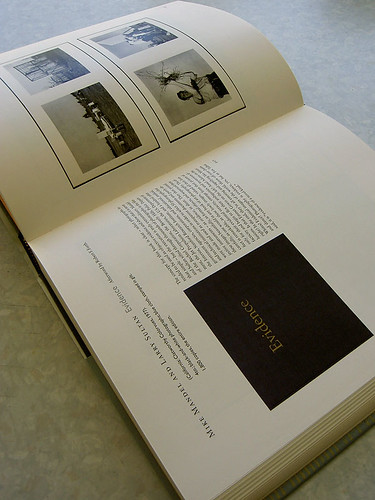
Must See Exhibition
Sadly I have not the cash to visit this show currently showing at SFMOMA, in San Francisco Museum of Modern Art, but err if you know anyone who wants to throw some cash around, I'll gladly go there and give a full report on it. I guess though the best way to see a show like this is Google the names of the exhibitors and put together your own exhibition of work.
The body of work I'd most like to see is that by Larry Sultan and Mike Mandel who are best known for their book 'Evidence' (1977) which used images found from a 3 year search of files and archives of over one hundred American government agencies, educational institutions, and corporations, and published 59 of them re-contextualised as a work of photographic art.*
A view I've long held and felt fairly passionate about but never can quite articulate it as well as I'd like to.
I guess the closest I will come to seeing this body of work is owning the book now reprinted and available of course on Amazon.

October 18, 2006
Surrealism Personified
Surrealism Personified
November 8, 2006
Disaster As Art?
Joerg Colberg over at conscientious, is pondering the issue of imagery made of disasters which is then paraded as Art in Galleries.
Robert Adams has an answer or two here, in an essay about Frank Gohlke's photographs of the storm that swept Wichita Falls, on April 10 1979, that ranked 4 on the Fujita Scale, he talks about form and meaning, and of metaphor.
“ His composition implies a belief in the endurance of meaning within an apocalyspe.”1
In the same book he also writes a lengthy article on “ Photographing Evil”, which I'll quote here, in an effort to offer some explanation as to why Photographers need to do this kind of work.
“ The point of art has never been to make something synonymous with life, however, but to make something of reduced complexity that is nonetheless analogous to life and thereby clarify it.”2
Not being the articulate writer that Mr Adams is I am unable to argue at length about the ideas being discussed in his books or offer much but to offer these couple of small snippets of hope for Joerg. Not to mention that I am not one to have the balls or temerity to go to the kinds of places such as war zones or sites of disaster and make images.
1 pg 100 Beauty in Photography, Essays in Defence of Traditional Values,pub. Aperture 1981
ISBN 0893810800
2ibid page 68
November 21, 2006
Woot
I have been accepted in to a small artist run space for a solo show in 2007. The space is called Trocadero Artspace, and the show dates are, 21 March to 1 April 2007.
The question now remains, use which 12 images from 'Across the River Styx'.
December 20, 2006
Petition
Save the Australian Photographic Portrait Prize now has it's own site please sign the petition and help re-instate this important cultural event.
December 27, 2006
Save The Australian Photographic Portrait Prize
The campaign to try and re-instate the Citi-bank Australian Photographic Portrait Prize, is well under way. We are starting to receive responses from galleries and curators, and we've had some input from political campaign manager types as well. Kent is constantly tweaking the site [if you haven't yet signed the petition please do so now!]. You can even check out previous winners of the prize to let the gallery know people are interested.
January 2, 2007
Exhibition Preparations I
While I am sitting here writing this on my g4 iBook laptop, my G3 desktop machine running OS 8.6 and Photoshop 5 has the ubiquitous clock icon spinning away madly. I have a 70 meg file open and am simply copying and pasting to clean up an the image I am working on. I have been 'cleaning up' this image for over 3 hours. Not unusual in this day and age of high rez scanners capable of capturing everything as well as the grain of the film.
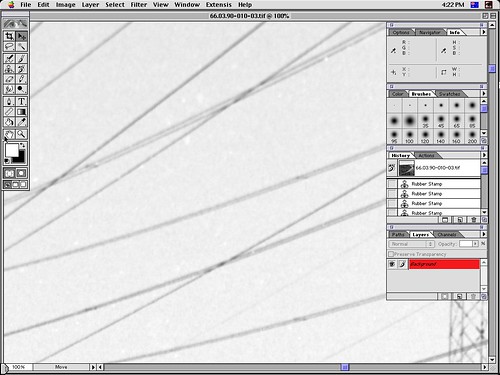
Earlier this morning I wanted a rough proof of the final 15 or so images I had scanned ready to edit down to the final 10 that will fit in the space.[yesterday I spent a few hours mocking up a 3d version of the space to visualise how the prints will look in there]. Given I had no way of connecting my older computer to my modern printer, or even connecting it to my new laptop, just getting a printed proof of the images proved a task in itself.
All up I'd say over 2 days of work have been spent on this show so far, and for which I have little to show. I remember thinking along these lines whilst doing my masters project in the late 90's. I seemed to spend equal amounts of time wrestling with my computer as I did actually making things. At one point I lost an entire week over an extension for my graphics tablet. This sort of stuff never happens in a darkroom, well rarely. You go in, set up your chemistry, get it to temperature and start printing. After an hour or two a decent but wet print should be in your hands and after a week of leisurely 6 hour days 12 - 24 prints should be ready to mount.
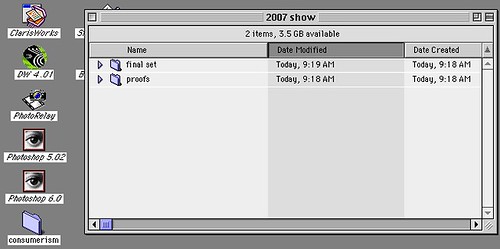
With computers forming such a large part of my creative output these days, it feels like things move at a far less productive pace. Even working between an Os 3 generations apart has it's moments.
Why am I using what is effectively a 10 year old OS and software? Both my astute readers may well be asking. There are several parts to this answer, some of which I have elaborated on in the past, others I may elaborate on in the future.
January 9, 2007
Exhibition Preps Week 2
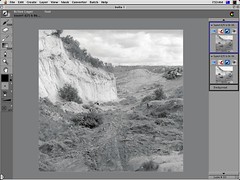
So begins the creative process of print manipulation. This in some ways is the hardest aspect of all. Where to start? When to stop, are all compounded by digital technologies. At least in an analogue environment you had to make a small test to determine a start time around which all other moves were based. With digital, well there it is on the screen, what more needs or can be done is the question you must ask, and hopefully if you have access to a good printer profile you can "preview" your image and make some decisions in the right direction.
Printing, on the other hand isn't going to be so straightforward? First question, how big? Well I know the answer to that up to 1 metre square. Next question. Inkjet print or Type C print?
Each have their relative merits, Type C prints, are tested for their durability, and being a chemical process are known to last for a certain amount of time, Inkjets are claimed to last as long, but of course this is based on accelerated testing methods, not real life, I have some inkjet prints made in 2000, they are ok but not perfect, unlike all my silver gelatin prints which ARE perfect still some dating back 20 years. The advantage of the inkjet printing is the vast amount of surfaces and materials one can have work printed upon. There are also some very nicely created printing profiles out there, that when used with a particular paper give almost silver gelatin photographic results.
Of course if I was simply, printing largish silver gelatin prints between 8 inches square and up to about 24 inches square, I would use silver gelatin paper. Which brings me back to where I started, and instead of spending my holidays on a computer, I would have been locked away in a darkroom making prints.
Indeed, "Everything in Photography is a trade off".
January 11, 2007
Inkjet Prints
Well Inkjet printing now becomes more of an option, I had heard about a profile or rip that allowed very good control over b&w prints from Epson Printers, a quick e-mail and I found the profile/rip in question. Now I can run my own small tests at least before I make any final decisions one way or the other.
January 12, 2007
Applying Analogue Approaches in a Digital Era
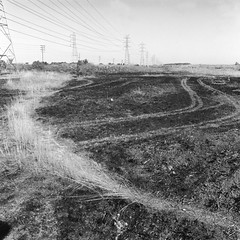
Well the initial worries about finishing my images in time for the show in have subsided; for the moment.
I am trying currently to spend quality time with the images I have and just make minor tweaks here and there. Not unlike a conventional darkroom where you make a test strip then a work print then several versions of that work-print until you are happy with the result.
This process in a darkroom environment, for me anyway, has always been one where decisions are easy to make, and sometimes the neg just prints beautifully, other times it has you scratching your head for hours, or even days, at worst months.
The speed of digital is of course somewhat of antithesis to this approach and somewhere in my Masters project back in 2000 I noted this. [One day I'll upload part of the written component, the actual body of photographic prints produced lives online in 2 places, flickr, of course and stunik.com*] So to tweak put away then come back a day or two later seems to be working for me at the moment.
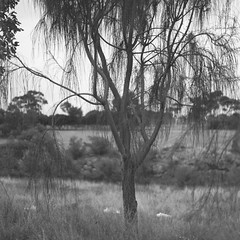
The converse of this is true also. When do you stop? When is an image finished?
I guess time is a deciding factor here. The best way to avoid this maybe to prepare images at the same time as writing gallery proposals and when a show gets accepted, cull down from a body of work already made?
Hopefully both my readers can see the differences between these "work prints" and the original scans that I uploaded as part of my 'Across the River Styx' 2007 proposed set on flickr. These are work-prints in their 2nd draft.
*this is a page buried deep in my old site in a dusty and cobweb ridden-corner that is unlikely to get a facelift, unlike my photoshop workshop page.
January 13, 2007
Side By Side Comparison
In response to a reader request*, I am posting two images in a side by side comparison, both are work prints.
I am going to leave any discussion about them till after the weekend, as I am running a weekend workshop in Photoshop this weekend, to pay for the mounting costs of the show of course. I will say this much, the change in orientation on this first one is an aesthetic choice and may yet change back depending on final planned hanging.
Original scan from proof.
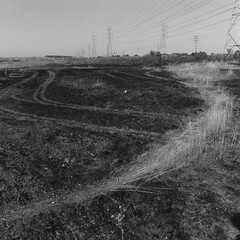
First Work Print

This one has a long way to go? Original Scan
![Deer Park Two [For Ian]](http://farm1.static.flickr.com/53/132514792_d07cda551c_m.jpg)
First Work Print

*This is a digital way of doing what I would normally do in the darkroom, extra special thanks to Addie for nudging me in this direction, the barcode reader will be in the mail soon.
January 16, 2007
Live Picture Workflow*
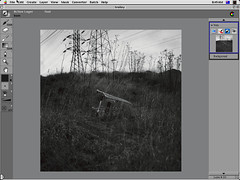
Insert the image.
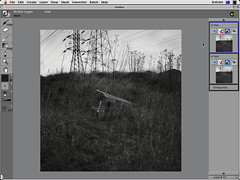
Duplicate the image layer.
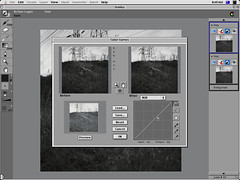
Adjust top image layer, using appropriate tools.
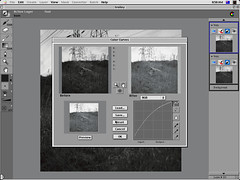
Curves have been applied.

The result.

Add another layer to start making some local adjustments.

Start tweaking numbers
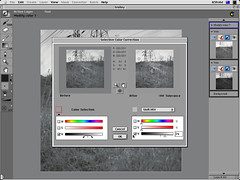
In this instance I've increased the value by about 10 units, almost a zone.

Brush all layers in and out in varying opacities as needed, be careful about when to stop. The conversion to jpeg seems to have buggered up the subtlety of the brushing in, trust it is smooth and subtle.
The power of this Application is that you are concentrating on the image, surrounded by minimal palettes, no other clutter on the desktop, and the application is only working and using the pixels you need to see and work on.
*or, how to procrastinate more than needed!January 17, 2007
Save The Australian Photographic Portrait Prize II

Kent, a friend, [and damn good photographer to boot] from Sydney was interviewed by the Sydney Morning Herald recently. He is also being interviewed by Radio 702 at 8:45 am tomorrow, 18.01.2007.
Go Kent, let's hope that the Citibank Australian Photographic Portrait Prize either gets re-instated or picked up by another gallery.
January 18, 2007
Radio Interview
Kent's radio interview on saving the Australian Photographic Portrait prize, should be able to be downloaded from the ABC 702's pod-casting page. The morning show, where Kent was interviewed, may also eventually upload the interview.
If somebody finds a down-loadable pod-cast first please let me know, so I can link to it.
January 22, 2007
Phone Cameras?

So yesterday I posed a question about Phone Cameras and thanks to all who responded. I've got to confess it's was a slightly loaded question, as I said I am thinking about putting together a short course/workshop in Phone Camera use and this is all heading somewhere.
Personally when I am trying to share some knowledge about anything I often try and list a series of pros and cons about what it is I'm try trying to share. And sure enough there has been some additions to the list by my readers.
While Phone Camera's up until recently had such poor levels of resolution, and small storage capacities, the whole idea of doing anything other than sending the photo to another phone user or posting on the web or e-mailing these images, were incomprehensible to phone users. Now with increased resolutions and phone storage capacities their uses are able to be extended, with some provisos.[Avant-garde image makers think differently I believe.]
Remember these are the modern equivalent of the 126 and 110 cameras of the 70's the latest incarnation in the idea that George Eastman brought to the Western world way back in the 1900's. Many many family histories have been recorded using these small cameras, not so many serious bodies of work though?. I am at a loss at the moment to remember anyone who has used a 126 or equivalent to produce a serious body of work however, and I don't consider Lartigue a candidate here as cameras were still in the realm of the wealthy middle and upper classes of the time.
Has anything changed since then that would allow people to make and record their lives differently? Well computers and the internet have impacted dramatically, the way folks capture and share images, these cameras are more than perfect for recording family histories, and small and easy enough to share almost immediately. With most people's expectations of these images are along the lines of, can I see what is important, faces scenery etc, these cameras then serve this function well under the right conditions, outdoors in bright sun for example. They are then able to say to themselves, "I'll send it or have it printed for my Mum/Aunty/Friend".
Such is the proliferation of these small cameras, that no longer do you even need a computer for this, most photo labs, in Melbourne anyway, have the ability to accept all sizes and shapes of memory cards to enable printing from any cameras including phone cameras or accept bluetooth transfers. So already we have the ability to not only electronically share our phone camera images but now print them out using traditional min-lab i.e. small prints.
I believe that electronic sharing of these images is more than enough to justify their use, the proliferation of photo sharing sites out there along with websites interested in the idea of alternative image making means a body of work can be produced and shared easily and quickly with as many like-minded people as you can find. Provided you accept the limitations of these cameras, and plenty of limitations they have.
So what other things can we do with these cameras? Well unless you are prepared to accept great seas of digital artefacts and horrendous lens aberrations, it's highly unlikely that you will be making 1 meter wide prints and exhibiting them, if on the other hand you are happy with a small print there are some other options outside of online publishing. With access to any desktop publishing software and a decent quality printer, you can print your own cards and books thus adding some meaning to the work you are making using these discrete little cameras. Possibly even creating a level of revenue that could justify the time and effort spent on printing them. There are even several online services that allow you to upload and publish, books cards and calendars, to an online store. This is based on the premise of a small book as file sizes are still on the low side to make anything bigger than 6 inches by 4 inches. I guess though, a 4 or 5 mega-pixel phone camera is only months away?
Hmm waffled on a bit today sorry?
Anyway here's my table of pros and cons.
| Pro | Con |
|---|---|
| Small, goes everywhere. | Small file size/s may inhibit output options, too many choices for the inexperienced. |
| Discrete, able to be used anywhere the user feels morally comfortable. | Certain social situations may not be the right place to make an image. |
Able to be sent anywhere anytime. |
Costs could become prohibitive, if not used wisely, not supported by all telephony providers. |
| Instant feedback. | Critical self-evaluation of images not encouraged.* |
| Almost infinite Depth of Field. | Poor Lens quality. |
| Wide Angle lens, wider angle of view than the human eye. | Wide Angle lens, wider angle of view than the human eye, requires skillful use and operation in terms of composition. |
| Zoom is digital. | Limited Zoom is digital resulting in high levels of noise. |
| Unpredictable results, giving weird colours strange movement and noise and blur. | Unpredictable results, may not be desirable depending on users aesthetic. |
| Unpredictable results. | No technical controls, f stops shutter speeds etc. |
| Limited choices means image maker must think hard about how to make a good image, without relying on zooming etc. | Limited accessory range. |
| Can be used anywhere where there is light. | Requires ample light, unless user can accept high levels of digital noise. |
January 23, 2007
Impromptu Spontaneous Photographers?
I guess if I really thought about it, photographers like Garry Winogrand [his wikipedia entry] and Robert Frank, have helped the cause of the snapshot Aesthetic, I wonder though what Mr Winogrand would have thought of mobile phone cameras, as for Robert Frank, I'd like to ask him personally about his thoughts on the matter?
January 24, 2007
The Antithesis Of Phone Cameras
Thanks to Joerg over at Conscientious here's a little movie on the very influential photographer Stephen Shore, and one of my favourite photographers.
His large format colour work of the 70's helped make colour an accepted art form. The type of camera he uses, and 8 x 10 inch, using colour neg/C41, and the approach is at the other end of the scale to the way a phone camera user would work.
January 25, 2007
First Print
So yesterday I finally got to print a print on our Epson 2100 printer at PIC. Close very close, some work required, and the profile from, Roy Harrington, is very good straight out of the box.
Pictures to come, seeing as a certain someone has misplaced a certain cable!January 26, 2007
February 4, 2007
February 5, 2007
Landscape art
Fantastic work
February 8, 2007
Ramped Up
Pressure is mounting for the upcoming solo-show, have collected 2 images from a Pro-Lab, not happy with the 'look' of the prints at all. However, I have been fortunate to have been put in touch with an Art School that prints large format. Had a quick chat last week with the guy in charge of the printing and am now proceeding with 7 inkjet pints 1 metre square.
Now I've just got to find 7 times $140.00!
Outside said art school I found this piece of graffiti, and of course the only capture device I had was a mobile phone, I made 2 images with it and chose this as the best one that expressed the idea.I felt the context from the surrounding Architecture was needed.

February 9, 2007
Street Photography

Yesterday I started to ramble on a little about the image I made using all I had at the time, I think I wanted to philosophise a little about that, but neglected to do so, and today I'm focused on re-scanning 7 images for the Solo show which opens on the 21st of March at Trocadero*. Today I've uploaded another image, taken this way, and again this image is made for similar reasons, it was the only device I had at the time and the characteristics of it suited the image. I wanted to exploit the features of the device and have an incredible amount of DOF. Capturing the objects themselves and the reflection across the street was the catalyst for this. Which I hope in turn says something about shopping, consumerism, light, photography, and representations of the human form... as well as ideas of beauty.
*Across the River Styx, opens at Trocadero Art Space, Level 1 119 Hopkins St Footscray on the 21st of March 2007 and runs until, the 30th of March.February 10, 2007
February 18, 2007
Exhibition Dates
A correction.
Sitting here at home today, designing my catalogue for my solo show, 'Across the River Styx' I realised I originally posted the wrong dates.
The correct dates are:-
21st of March, to the 7th of April 2007.
Trocadero Art Space, Level 1, 119 Hopkins St,
Footscray,
9687 6110
Opening night is the 24th of March.
Once I have completely finished the catalogue, I will upload a pdf file for either of my readers, who might like to see it.
February 28, 2007
Online Exhibition
Submit a piece to this gallery and have your work exhibited in Musée de l'Elysée, Lausanne, in the show entitled, "The rapid mutation of amateur photography in the digital age"
They are asking some pertinent and burning questions, among them:-
Does the digital shift constitute a revolution, or merely an evolution?
Does the shift represent a real democratization of photography?
Is citizen photojournalism worthy of its name?
Does the shift threaten the livelihood of professional photographers in fundamental ways?
Does the shift represent a shift towards more authenticity or truthfulness — or less?
Looks like others are thinking along the same lines, which is good I enjoy a good quest.
Technorati Tags: art, interwebs, photography
March 2, 2007
On Track
So yesterday I spent some time in VCA's Lab looking at my work on their monitors, with Andrew. Very very happy. Things are moving along nicely. The monitor differences were noticeable enough to come back and do some more tweaking at home, but not so much that I'm feeling swamped by it all.
The monitors they use are quite expensive and very finely calibrated, mine is a good monitor and is probably due for a calibration, I however prefer my monitor, a CRT, over theirs, LCDs. I am now actually getting excited about the show. For a while there in January it was all a bit nerve wracking, particularly in terms of timeframes and workloads, but thanks to Live Picture, things are on track. One day I'll write extensively about the experience of using Live Picture over Photoshop — if both my readers haven't already deduced from my ramblings how easy it is to use, how elegant fast and graceful. Some days however you feel a little guilty spending so little time hammering away at an image, these past few weeks has been just like that.
On an unrelated note, I will be without interwebs for a couple of days this weekend. I may however still be able to post to my Mophone Blog, so if you're interested pop on over there and have a peek, who knows what might turn up?
Technorati Tags: art, Inkjet Prints, interwebs, Live Picture, photography, VCA
March 7, 2007
Overseas Exhibition

Some interesting news, I submitted some work to an online exhibition, it was exhibited in the space recently, in Switzerland, and I didn't even leave Melbourne.
This is the e-mail I received from the gallery yesterday.
Dear Photographer,
Your image was shown in the Musee de l'Elysee's exhibit ‘We are all photographers now!’ in the last few days. Enclosed you will find an installation view of your image that shows it in the wall.
The visitors to the exhibit are fascinated by all the different photographs that are being shown from participants like you from all over the world. Thank you again for participating and please feel free to upload more images to the site allphotographersnow.ch.
We also sincerely hope you will visit the museum. The dates of the exhibition ‘All photographers now!’ are from February 8th, 2007 to May 20th, 2007.
From the team at the Musee de l'Elysee</blockquote>So there ya go eh? My first overseas showing.
Technorati Tags: landscape, photography
March 9, 2007
Counting Down the Days
Paid the final deposit yesterday, my solo show is signed sealed and delivered. Sadly though the invites have been delayed, but soon, very soon.
More information has come to hand on the opening night, it is on from 4:00pm to 6:00pm, at Trocadero Level 1 119 Hopkins St. Footscray, not unusual I guess in some respects, perhaps a little early, but hey more time to party afterwards.
Technorati Tags: Inkjet Prints, photography, solo show, trocadero
March 10, 2007
Exhibition Invites
Don't know why but I was a little surprised to receive a text message yesterday announcing the arrival of the printed invites for my show at Trocadero. Surprised by the text message NOT the announcement.
Anyways, if you want hard copy invitations, I can arrange it to be delivered, I suspect however that a quick visit to the gallery, at Level 1 119 Hopkins St. Footscray, you'll be able to pick up some invites there. In case you have trouble finding the place, you actually enter from Barkly St., not Hopkins.
Contact me if you want a real invite, and I'll do my best to mail them out ASAP. [A word of warning, I'm a terrible at using snail mail, a real snail myself]
Technorati Tags: australia, photography, invitations, melbourne, solo show, trocadero, exhibition, gallery
Here They Are
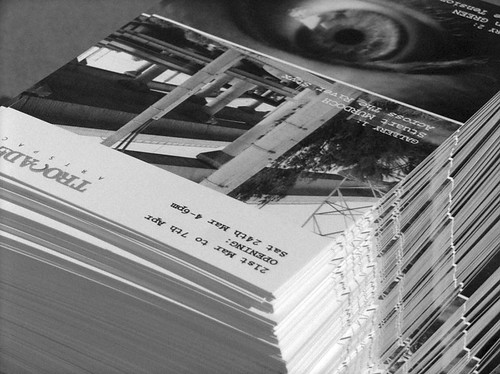
Contact me if you want one.
Technorati Tags: exhibition, gallery, invitations, photography, solo show, trocadero
March 13, 2007
Lo-Fi cont'd

So again here's a low-rez, lo-fi image, of indeterminate subject matter, other than that one may have a vague idea that it is probably a photograph, there are no real indicators of what it is either way.
Does this a) make it a worthwhile object of contemplation, or b) yet another piece of detritus in the ever growing heap that is digital image making?
Technorati Tags: cameras, low-rez, mophone, phonecam, photography
April 4, 2007
Swiss Exhibition
Now after 3 pieces in the Show in Switzerland, here's a youTube piece on the opening night.
Technorati Tags: conceptual, exhibition, gallery, photography
April 5, 2007
Current CCP Show
Went to the CCP yesterday, to see the Anne Zahalka Show, while I contemplate my response, consider this.
"The photographic process looks after itself when its natural inheritance is honoured. It can not understand any other way of working. But when what is passed on represents a loss, the process collapses."
Les Walkling
Technorati Tags: CCP, conceptual, melbourne, photographic, photography, pomo, portraits
April 6, 2007
Anne Zahalka at the CCP April 2007
When I recently heard about the current show at the CCP of Anne Zahalka's work, I was quite excited.
I spent some time at the show on Wednesday just gone, and well, to be frank, I was disappointed.
The show is really well hung, the staff at the CCP have done a great job. The large light box, in gallery 3 is mind blowing. The rest of the work itself however has a level of inconsistency about it's printing that makes me wonder if it is even by the same artist? I was really looking forward to seeing the work in gallery 2, her best known I suppose, but was sadly disappointed by the prints, they seemed to lack any richness, and I was not even sure they had been shot on medium format, due to poor sharpness and what appeared to be chromatic abberations. The body of work in gallery 1, the Artist series, really has me perplexed because it is so obviously digital, but the material it is printed on takes it almost to a sculptural level. The ideas themselves are of course engaging and humorous, but I'm kind of left gasping when there seems to be so little to tie them together.
Technorati Tags: CCP, conceptual, exhibition, gallery, melbourne, photographic, photography
Search
About art
This page contains an archive of all entries posted to musings from the photographic memepool [the shallow end] in the art category. They are listed from oldest to newest.
exhibitions is the next category.
Many more can be found on the main index page or by looking through the archives.
Movable Type 3.35




